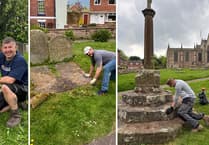Coal Mining in the Forest of Dean was the topic of the talk given by Malcolm Bowring to the Ross Library Development Group in late September.
He outlined the contrast of the quiet woods and tranquil paths that we know and love today, with the noisy, dirty industry of 100 years ago.
At the peak of coal production, in 1914, 5,478 men were employed in the coal mines. There were about a dozen major, deep pits and the output was nearly one million tons per year. The last deep mine closed in 1965. Since 1800, more than 600 men died in the Forest coal mines.
Freeminers were unique to the Forest of Dean. To qualify, a man had fulfil certain criteria:?he had to have been born in the Hundred of St Briavels, be 21 years of age, and have worked in a Free Mine for a year and a day. The rights were regulated by The Deputy Gaveller, a post which still exists.
The area granted to a Free Miner is a Gale, which is a 12 yard radius around a designated spot for which fees were paid.
To this day, only a few of them are still mining on a small scale, with drift mines.
The main coal seams in the Forest were between 500 and 1000 feet below ground, which meant that deep shafts needed to be sunk. When the coal was reached, a roadway was dug which sloped as it followed the seam.
The coal seam was often no more than four feet thick, so the miner had to dig out the coal with a pick, either kneeling or lying on his side. For light he had a candle, fixed to a stick, called a ‘nellie’, which he held between his teeth.
Young boys pulled ‘hods’, shallow wooden boxes, mounted on skids, laden with up to 1.5 cwt. of coal, along the face to be loaded into tubs which were lifted to the surface with a winding engine.
One boy could shift up to eight tons of coal a day, pulling the hod on his hands or knees with a leather harness over his head, across his shoulders and between his legs. Flooding in the mines was a constant hazard.
This use of children continued until the Mines Act of 1842, which prohibited the employment of women and of boys and girls under ten years of age.
From the start of the 19th century, investors came from outside the Forest, ‘foreigners’, and employers such as William Crawshay, Edward Protheroe and Josiah John Guest bought or leased the gales. They introduced steam pumping and winding engines. Employment and production soared.
Mr Bowring described the increasingly sophisticated means of transport, from tram roads to railways, and detailed the improvements in working conditions, such as the first pit-head baths at Cannop Colliery in 1929.
Two members of the audience had worked in the mines and a retired GP, with 40 years experience in the Forest, spoke of the harsh living conditions.
The next RLDG talk will be on Tuesday, October 18th, at 7.30pm at Ross Library. The CEO of the Hope Support Services will describe the work that the Ross-based charity do to support young people in Herefordshire and Gloucestershire through family health crises.
All are welcome. It costs £4.00 entry for RLDG members and £5.00 entry for non-members, and students can attend for free.





Comments
This article has no comments yet. Be the first to leave a comment.